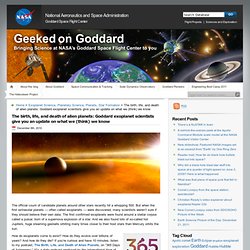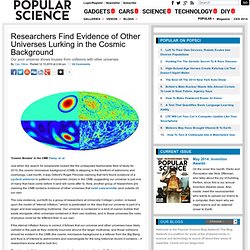

CHART OF THE DAY: Most People Use Only 4 Apps. Geeked on Goddard » The birth, life, and death of alien planets: Goddard exoplanet scientists give you an update on what we (think) we know. The official count of candidate planets around other stars recently hit a whopping 500.

But when the first extrasolar planets — often called exoplanets — were discovered, many scientists weren’t sure if they should believe their own data. The first confirmed exoplanets were found around a stellar corpse called a pulsar, born of a supernova explosion of a star. And we also found lots of so-called hot Jupiters, huge steaming gasballs orbiting many times closer to their host stars than Mercury orbits the sun. How do exoplanets come to exist? How do they evolve over billions of years? The race is still on to discover more planets, and scores are promised thanks to missions like the Kepler space observatory. Here at NASA’s Goddard Space Flight Center, where I work as a science writer, we’ve got a whole group of scientists obsessed with exoplanets. DANIEL PENDICK: That’s Jennifer Wiseman. JANG-CONDELL: So basically you’ve got a star. PENDICK: Hold on — did she say dust? NASA’s Cassini orbiter snaps unbelievable picture of Saturn.
Sometimes reality is just as stunning as science fiction Science fiction movies have spoiled us on high definition views of our planetary neighbors, but real-life photographs with equal jaw-dropping potential are exceedingly rare.

That's what makes NASA's awe-inspiring snapshot of Saturn (hi-res version here) such a stunning piece of eye candy. View the Universe in different wavelengths. Ever wanted X-ray specs or super-human vision?

Chromoscope lets you explore our Galaxy (the Milky Way) and the distant Universe in a range of wavelengths from gamma-rays to the longest radio waves. Change the wavelength using the slider in the top right of the screen and explore space using your mouse. For more information we have a quick video tour or you can read more on our blog. If you get stuck, click "Help" in the bottom left. Chromoscope is kindly funded by the Cardiff University Astronomy and Astronomy Instrumentation Groups. Took 1598ms to load. Astronomy Resources at STScI. Star Found Shooting Water "Bullets" (Build 20110413222027) Seven hundred and fifty light-years from Earth, a young, sunlike star has been found with jets that blast epic quantities of water into interstellar space, shooting out droplets that move faster than a speeding bullet.

The discovery suggests that protostars may be seeding the universe with water. These stellar embryos shoot jets of material from their north and south poles as their growth is fed by infalling dust that circles the bodies in vast disks. "If we picture these jets as giant hoses and the water droplets as bullets, the amount shooting out equals a hundred million times the water flowing through the Amazon River every second," said Lars Kristensen, a postdoctoral astronomer at Leiden University in the Netherlands. (Related: "Dimmest Stars in Universe Spotted? ") Water Vanishes, Only to Reappear Located in the northern constellation Perseus, the protostar is no more than a hundred thousand years old and remains swaddled in a large cloud—gas and dust from which the star was born. Researchers Find Evidence of Other Universes Lurking in the Cosmic Background. Just when the search for exoplanets looked like the undisputed fashionable field of study for 2010, the cosmic microwave background (CMB) is stepping to the forefront of astronomy and cosmology.

Last month, it was Oxford's Roger Penrose claiming that he'd found evidence of a cyclical universe in patterns of concentric circles in the CMB, suggesting our universe is just one of many that have come before it (and will come after it). Two Suns? Twin Stars Could Be Visible From Earth By 2012. NASA spots smallest planet yet discovered outside Sun's solar system. The object is the first rocky planet discovered by NASA's Kepler spacecraftThe discovery has scientists optimistic about what else could be foundKepler is capable of finding Earth-size planets in a habitable zone, NASA says (CNN) -- A NASA spacecraft has detected a rocky planet that is the smallest ever discovered outside the Sun's solar system, the agency announced Monday.

The exoplanet -- so named because it orbits a star other than the Sun -- has been dubbed Kepler-10b. It measures 1.4 times the Earth's diameter and was confirmed after more than eight months of data collection, the agency said. It is the first rocky, or Earth-like, planet discovered by Kepler. Vatican Joins Search For Alien Life. VATICAN CITY -- E.T. phone Rome.

LeapTag Article View. Other Web Cam Options for Viewing the Lunar Eclipse. Other Web Cam Options for Viewing the Lunar Eclipse Cloudy skies over much of the U.S. might make for challenging viewing tonight for the solstice lunar eclipse.

To help work around the mercurial weather, here’s a list of web sites that are offering live web views. Space tech. Ned Wright's Cosmology Tutorial - (Build 20100401064631) News of the UniverseFrequently Asked QuestionsEnter the tutorial or the Italian version or the French version Cosmological fads and fallacies CMB SpectrumCMB AnisotropyBig Bang NucleosynthesisSupernova ObservationsCosmology, Religion & KansasSend me your comments.
